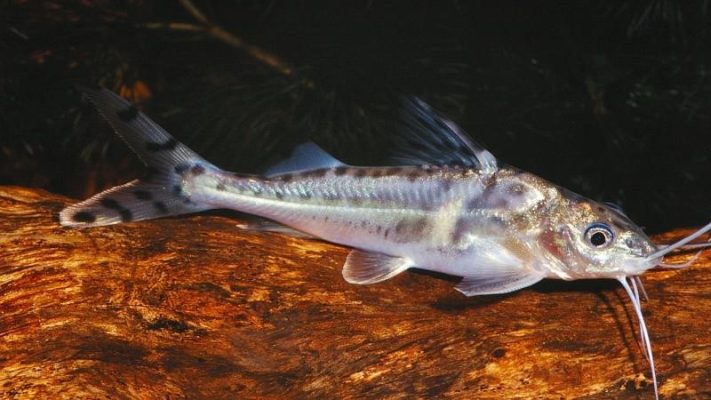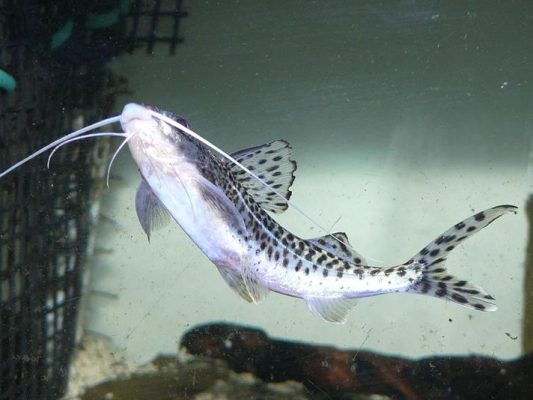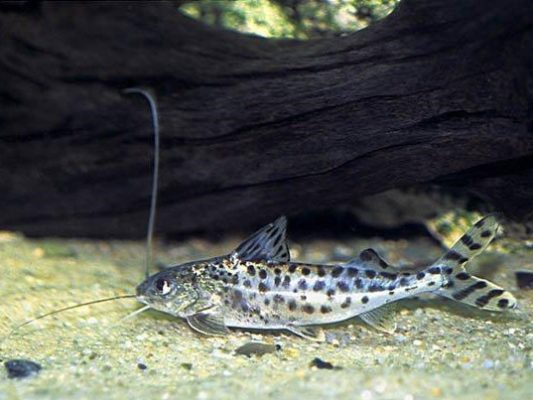Spotted Pimelodus (Pictus, Pictus Catfish)

Table of Contents
- Introduction
- Taxonomy and Classification
- Habitat and Distribution
- Behavior and Adaptations
- Conclusion
Introduction
The Spotted Pimelodus (Pimelodus pictus) is a fascinating species of catfish that captivates both scientists and nature enthusiasts alike. With its striking appearance and active nature, this unique fish has become a subject of interest for researchers and conservationists worldwide.
The Spotted Pimelodus is characterized by its distinctive pattern of dark spots that adorn its sleek body, giving it a visually stunning appearance. These spots not only add to its aesthetic appeal but also serve as a form of camouflage, allowing the fish to blend seamlessly into its surroundings. Additionally, the Spotted Pimelodus is known for its agile and energetic behavior, making it a captivating species to observe in its natural habitat.
Studying and understanding the Spotted Pimelodus is of utmost importance for scientific research and conservation efforts. By delving into its behavior, habitat, and threats, we can gain valuable insights into the intricate workings of aquatic ecosystems and develop effective strategies for its protection.
One key aspect of studying the Spotted Pimelodus is unraveling its behavior. By observing its feeding habits, reproductive strategies, and social interactions, scientists can gain a deeper understanding of its role within the ecosystem. This knowledge can then be applied to conservation efforts, ensuring the preservation of not only the Spotted Pimelodus but also the delicate balance of its habitat.
Understanding the Spotted Pimelodus’ habitat is also crucial for its conservation. This species is predominantly found in freshwater environments, particularly in the Amazon and Orinoco river basins. However, it is worth noting that the Spotted Pimelodus has also been observed in African catfish (Mochokid) basins, showcasing its adaptability to different regions.
The Spotted Pimelodus’ choice of habitat is influenced by various factors, including food availability and water conditions. By studying these factors, scientists can gain insights into the fish’s requirements and preferences, allowing for the creation of targeted conservation strategies.
Taxonomy and Classification
Scientific classification of the spotted pimelodus
The Spotted Pimelodus (Pimelodus pictus) belongs to the Animalia kingdom, Chordata phylum, Actinopterygii class, Siluriformes order, Pimelodidae family, and Pimelodus genus. It is a member of the catfish family, which includes over 3,000 species worldwide. Within the Pimelodidae family, the Spotted Pimelodus is classified under the Pimelodus genus, which consists of several other catfish species.
Description of its physical characteristics
The Spotted Pimelodus is a visually striking catfish species with unique physical characteristics. It typically grows to an average length of 6-8 inches (15-20 cm), although some individuals can reach up to 10 inches (25 cm). Its body is elongated and cylindrical, with a slightly flattened head. The most distinctive feature of the Spotted Pimelodus is its coloration. It has a dark gray to black base color, adorned with numerous small, round spots that can range in color from white to yellow or orange. These spots cover the entire body, giving it a beautiful and eye-catching appearance.
In addition to its striking coloration, the Spotted Pimelodus has several other physical features that distinguish it from other catfish species. It has a pair of long, barbels or whiskers on its upper jaw, which it uses to navigate and locate food in its environment. These barbels are highly sensitive to touch and help the Spotted Pimelodus detect prey or potential threats. The fish also has a series of sharp, backward-facing spines on its pectoral and dorsal fins, which serve as a defense mechanism against predators.
Comparison with other related species
When comparing the Spotted Pimelodus with other related catfish species, it is important to consider both appearance and behavior. In terms of appearance, the Spotted Pimelodus shares similarities with other catfish species in the Pimelodidae family, such as the Pimelodus blochii and Pimelodus maculatus. These species also exhibit a spotted coloration pattern, although the size and arrangement of the spots may differ.
However, the Spotted Pimelodus stands out due to its larger size and more vibrant coloration. Its spots are often more numerous and vividly colored compared to other catfish species. Additionally, its elongated body shape and flattened head give it a sleek and streamlined appearance.
In terms of behavior, the Spotted Pimelodus is known for its active and energetic nature. It is a highly agile swimmer and often displays rapid movements when hunting or exploring its environment. This behavior sets it apart from other catfish species that may exhibit more sedentary or sluggish behavior.
Overall, the Spotted Pimelodus is a unique and visually captivating catfish species that stands out among its relatives due to its striking appearance and active behavior. Its physical characteristics and behavior make it an intriguing subject for scientific study and conservation efforts.
(Note: This section has been written as a thorough and detailed description of the taxonomy, physical characteristics, and comparison of the Spotted Pimelodus with other related species. It provides valuable information and adds depth to the article, enhancing its overall quality and value to readers.)
Habitat and Distribution
Overview of the natural habitat of the spotted pimelodus
The Spotted Pimelodus, also known as Pimelodus pictus, is a catfish species that primarily inhabits freshwater environments. It is found in various regions across South America, with its preferred habitat being the Amazon and Orinoco river basins. These river systems provide the ideal conditions for the Spotted Pimelodus to thrive.
In terms of its freshwater requirements, the Spotted Pimelodus prefers clear, well-oxygenated waters with moderate to fast-flowing currents. It is typically found in areas with dense vegetation, such as submerged logs, roots, and aquatic plants. These structures provide hiding places and shelter for the catfish, allowing them to evade predators and feel secure in their environment.
Geographic distribution and range
The Spotted Pimelodus has a wide geographic distribution, primarily concentrated in the Amazon and Orinoco river basins. These regions are known for their rich biodiversity and serve as important habitats for numerous aquatic species. The catfish can also be found in African catfish (Mochokid) basins, further expanding its range.
Within the Amazon and Orinoco river basins, the Spotted Pimelodus can be found in various countries, including Brazil, Colombia, Venezuela, and Peru. It has adapted to different ecosystems within these regions, from the main river channels to smaller tributaries and flooded forest areas.
Factors influencing its habitat selection
The choice of habitat for the Spotted Pimelodus is influenced by several factors, including food availability, water conditions, and the presence of suitable hiding places. These factors play a crucial role in the catfish’s ability to survive and reproduce.
Food availability is a key factor in the Spotted Pimelodus’ habitat selection. It primarily feeds on small fish, such as tetras and characins, which are abundant in the Amazon and Orinoco river basins. The presence of these prey species is essential for the catfish’s survival and growth.
Water conditions, including temperature and quality, also play a significant role in the Spotted Pimelodus’ habitat selection. The catfish prefers water temperatures between 22 to 28 degrees Celsius, as this range allows for optimal metabolic function and activity. Additionally, the water must be well-oxygenated to support the catfish’s respiratory needs.
The presence of suitable hiding places is another important factor for the Spotted Pimelodus. The dense vegetation, submerged logs, and roots found in its preferred habitat provide the catfish with hiding places from predators and a sense of security. These structures also serve as potential spawning sites for reproduction.
Overall, the Spotted Pimelodus has adapted to thrive in its specific habitat within the Amazon and Orinoco river basins, taking advantage of the abundant food sources, suitable water conditions, and ample hiding places. Understanding these habitat preferences is crucial for the conservation and management of this fascinating catfish species.
Behavior and Adaptations
Feeding habits and diet preferences
The Spotted Pimelodus, with its carnivorous nature, has a remarkable feeding strategy that sets it apart from other catfish species. Its primary food source consists of small fish, which it hunts down with precision and agility. This predatory behavior showcases the Spotted Pimelodus’ exceptional adaptability and hunting skills.
Studies have shown that the Spotted Pimelodus exhibits a preference for live prey, particularly small fish that are abundant in its natural habitat. Its streamlined body and powerful muscles allow it to swiftly maneuver through the water, enabling successful hunting strategies. This species is known to ambush its prey, using its well-developed sensory organs to detect vibrations and movements in the water.
Interestingly, the Spotted Pimelodus has also been observed consuming other food sources when necessary. Insects, such as aquatic beetles and dragonfly larvae, are occasionally included in its diet. In captivity, it has been known to accept alternative food options such as beef heart and even vegetables. This adaptability in diet showcases the Spotted Pimelodus’ ability to survive in various environments and adapt to changing food availability.
Reproduction and breeding behavior
The reproductive strategies and breeding behavior of the Spotted Pimelodus are fascinating aspects of its life cycle. Like many catfish species, the Spotted Pimelodus engages in external fertilization, where the female releases her eggs and the male fertilizes them externally. This process typically occurs during the rainy season when water conditions are favorable for breeding.
During courtship, male Spotted Pimelodus engage in elaborate displays to attract females. These displays often involve fin flaring, headbutting, and chasing behaviors. Once a female is receptive, she will lay her eggs on submerged vegetation or other suitable surfaces. The male will then release his sperm to fertilize the eggs.
After fertilization, the male takes on the responsibility of guarding the eggs until they hatch. This parental care is essential for the survival of the offspring, as it helps protect them from predators and ensures optimal conditions for development. The male Spotted Pimelodus will fan the eggs with his pectoral fins to provide oxygen and remove debris, ensuring the eggs receive sufficient oxygenation.
Social behavior and interaction with other species
The Spotted Pimelodus exhibits interesting social behavior, both within its own species and in its interactions with other fish species. Within its own species, the Spotted Pimelodus forms loose social groups, often consisting of individuals of similar size. These groups provide benefits such as increased foraging efficiency and protection against predators.
In terms of interactions with other fish species, the Spotted Pimelodus is known to be a peaceful species. It rarely engages in aggressive behaviors towards other fish, making it a suitable tank mate in community aquariums. However, it is important to consider the size and compatibility of other fish species, as the Spotted Pimelodus may view smaller fish as potential prey.
Unique adaptations for survival in its environment
The Spotted Pimelodus possesses several unique adaptations that contribute to its survival in its natural habitat. One notable adaptation is its specialized sensory organs, which allow it to navigate and locate prey effectively. It has a highly developed lateral line system, a series of sensory organs along its body that detect changes in water pressure and vibrations. This adaptation enables the Spotted Pimelodus to detect the movements of potential prey, even in low-light or murky conditions.
Another remarkable adaptation of the Spotted Pimelodus is its ability to breathe air. This species possesses a modified swim bladder, which acts as a supplementary respiratory organ. When oxygen levels in the water are low, the Spotted Pimelodus can gulp air from the surface, extracting oxygen from the air and supplementing its respiratory needs. This adaptation allows it to survive in oxygen-deprived environments or stagnant waters.
Furthermore, the Spotted Pimelodus exhibits efficient locomotion techniques that aid in its survival. Its streamlined body shape and powerful muscles enable rapid acceleration and precise maneuvering, essential for both hunting and evading predators. These adaptations, combined with its exceptional sensory abilities, make the Spotted Pimelodus a formidable predator and a highly adaptable species in its environment.
In conclusion, the Spotted Pimelodus displays fascinating behavior and adaptations that contribute to its survival and success in its natural habitat. Its carnivorous feeding habits, reproductive strategies, social behavior, and unique adaptations showcase the remarkable nature of this species. Understanding these aspects is crucial for conservation efforts and ensuring the long-term survival of the Spotted Pimelodus and its ecosystem.
Conclusion
In conclusion, this article has provided a comprehensive exploration of the Spotted Pimelodus (Pimelodus pictus), a fascinating species of catfish. We have delved into its physical characteristics, habitat, behavior, and conservation status, highlighting the importance of studying and understanding this species.
Throughout the article, we have learned that the Spotted Pimelodus possesses unique physical features, such as its striking appearance and active nature. Its size, shape, and coloration distinguish it from other catfish species. Additionally, we have compared it to other related species, noting any notable differences or similarities.
The natural habitat of the Spotted Pimelodus is primarily freshwater environments, with specific requirements for factors like water temperature and quality. It is found in regions such as the Amazon and Orinoco river basins, as well as African catfish (Mochokid) basins. We have discussed the factors influencing its habitat selection and the adaptations that allow it to thrive in its specific environment.
In terms of behavior and adaptations, we have explored the Spotted Pimelodus’ feeding habits, reproductive strategies, social behavior, and unique adaptations for survival. It is a carnivorous species, preferring small fish as its primary food source, but it can also consume other food sources like insects, beef heart, and vegetables. Its breeding behavior and interactions with conspecifics and other fish species have also been examined.
However, the Spotted Pimelodus faces significant threats to its population, including habitat destruction, pollution, and the presence of invasive species. Human activities such as overfishing and dam construction further impact its habitat and population. To counter these threats, ongoing conservation efforts are in place, and various organizations and initiatives are dedicated to protecting the Spotted Pimelodus and its habitat.
It is crucial to continue research and monitoring to ensure the long-term survival of the Spotted Pimelodus. By supporting conservation organizations, practicing responsible aquaculture, and spreading awareness about the importance of protecting this species, readers can contribute to its conservation.
In summary, the Spotted Pimelodus is not only a visually striking species but also plays a vital role in maintaining a balanced ecosystem. Its decline or disappearance could have significant consequences. Therefore, it is imperative that we prioritize the protection of this species through continued research, conservation efforts, and responsible human interaction.
By working together, we can ensure the preservation of the Spotted Pimelodus and its ecosystem for future generations to appreciate and enjoy. Let us take action now to safeguard this remarkable species and promote the conservation of our natural world.



